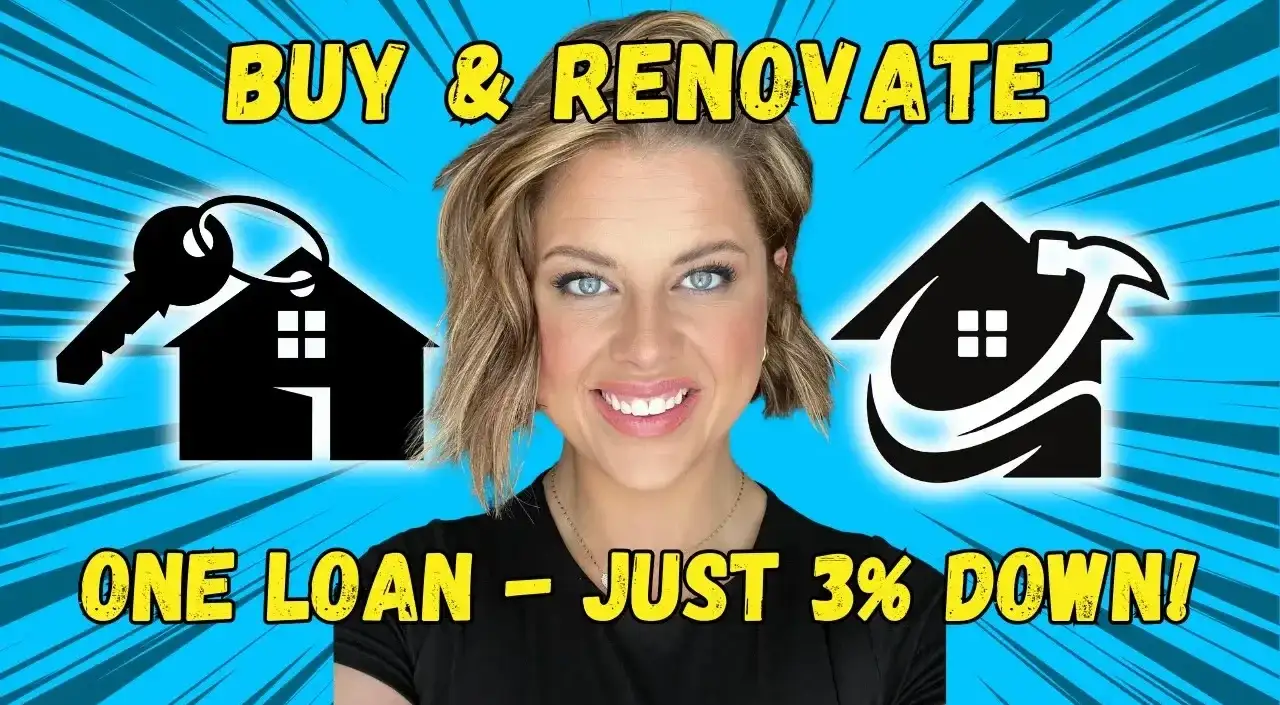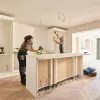Looking At Fixer-Uppers? Try A Conventional Rehab Loan. Yes, Really.

With the recent rise in real estate prices, buyers are increasingly turning to fixer-upper properties to stretch their funds and get the most value out of their new homes.
But even if you’ve found a fixer-upper, you may be wondering how to finance it. You’ve probably already heard that FHA and conventional loan programs won’t finance a home that’s too beat up.
While there is some truth to that statement, conventional loan agencies Fannie Mae and Freddie Mac offer loan rehab programs that allow you to finance the home purchase and renovation costs with one mortgage. The best part: most single-unit fixer-upper properties can be purchased with as little as 3% down, including purchase and repair costs.
Let’s take a closer look at how these loans work.
Key Takeaways
- Conventional rehab loans combine home purchase and renovation costs into one mortgage with as little as 3% down.
- Fannie Mae’s HomeStyle and Freddie Mac’s CHOICERenovation cover a wide range of renovations, including luxury upgrades.
- Both programs allow DIY repairs and let you choose contractors with lender approval.
- Loans can cover up to six months of mortgage payments if your home is uninhabitable during renovations.
- Freddie Mac CHOICEReno eXPress is available for small-scale repairs and cosmetic upgrades.
How Conventional Rehab Loans Work
Conventional rehab loans allow you to finance a property's purchase and its renovation costs in a single mortgage, making them an attractive option for buyers looking at fixer-uppers. Here's a high-level look at how they work:
- Loan Application: You’ll apply for the loan just like any other mortgage, but you’ll also need to provide detailed plans for the renovations and improvements. These plans typically include cost estimates, contractor bids, and a timeline for completing the work.
- Property Appraisal: The lender orders an appraisal based on the “as completed” value of the home, which estimates how much the property will be worth after the renovations are finished.
- Loan Approval: The loan amount is based on the lesser of the purchase price plus renovation costs or the appraised “as completed” value. Once approved, the loan closes, and funds are made available for both the home purchase and the renovation.
- Renovation Process: Funds for renovations are placed in escrow and released as work is completed. You may need inspections at certain stages to verify the progress of the renovations.
- Completion and Final Inspection: Once the renovations are finished, the lender will typically require a final inspection to ensure the work is complete and up to code. After approval, any remaining funds are disbursed.
Conventional Rehab Loan Options
You have three main options for conventional rehab loans. Which one you choose will likely depend on the extent of repairs and improvements.
Fannie Mae HomeStyle Renovation
Fannie Mae's HomeStyle Renovation loan allows you to buy a fixer-upper with as little as 3% down. It can even be used to finance repairs on a second home or investment property, with a larger down payment. Plus, you have the freedom to choose your contractors, as long as they meet lender requirements, or even do some of the repairs yourself.
Eligible Repairs: There are no restrictions on the types of renovations allowed, but improvements must be permanently affixed to the property.
Note: Renovations typically refer to work that restores a property, such as fixing the roof or foundation. Improvements are changes that add value through new features, like a deck, a swimming pool, etc.
You may, however, purchase appliances for your home if you're completing substantial work on the room they're placed in.
You can even use your HomeStyle Renovation loan for an inground pool or detached garage, or to improve your home's landscaping. Plus, you can allocate funds for up to six months of mortgage (PITI) payments for primary residences that are uninhabitable during renovations.
Funds can also be used for renovation-related costs such as:
- Permitting
- Inspections
- Architectural/Engineering Services
- Consultant Fees
Maximum Loan: 97% of the lesser of the 1) purchase price plus estimated renovations, or 2) “as completed” appraised value. Renovations may account for up to 75% of the total loan (the lesser of 50% or $50,000 for manufactured housing). Loans are also subject to current conforming loan limits.
Property Types Allowed: One to four-unit primary residence, one-unit second home or investment property, manufactured home, or a single unit in a condo, co-op, or PUD.
DIY Allowed? Yes, for one-unit properties (except manufactured homes). DIY renovations must account for no more than 10% of the property’s total completed value, and inspections are required for work items over $5,000. Funds are available for materials and contract labor, but you can’t reimburse yourself for your own labor.
Contractor Requirements: Buyers may choose their contractors, but lenders must verify that the contractor is adequately qualified and experienced to complete the work required. Lenders will typically request a Contractor Profile Report to assess eligibility.
Down Payment:
Property Type: |
Down Payment: |
One-Unit Primary Residence: |
3-5% |
2-Unit Primary Residence: |
5% |
Three & Four Unit Primary Residence: |
5% |
One-Unit Second Home: |
10% |
One-Unit Investment Property: |
15% |
Minimum Credit Score: 620
Contingency Reserve: 10% of total renovation costs required on two to four-unit properties. Lenders may require 15% in some situations. A contingency reserve may be required at the lender's discretion for single-unit properties.
Time Limit for Repairs: All renovations must be completed at most 15 months after closing.
Freddie Mac CHOICERenovation® Mortgage
Like the Fannie Mae HomeStyle Renovation loan, Freddie Mac's CHOICERenovation program allows you to buy a fixer-upper and finance repairs with as little as 3% down. You can use the funds for nearly any permanent renovation and can even hire contractor services from home improvement stores.
Eligible Repairs: Like with Fannie Mae's HomeStyle Renovation loan, funds can be used to finance most renovations permanently affixed to the property. However, Freddie Mac's CHOICERenovation program allows for purchasing new appliances without requiring renovations to the room they're in.
CHOICERenovation loans allow funds to be used for up to six months of mortgage (PITI) payments for primary residences if you won’t be able to live in your home during the improvement process. Freddie Mac also allows luxury improvements like inground pools and landscaping enhancements.
Plus, you can use your CHOICERenovation loan to pay improvement-related costs, including:
- Permits
- Appraisals
- Inspections
- Title Updates
Maximum Loan: 97% (when combined with a Home Possible mortgage) of the lesser of the 1) purchase price plus estimated renovations, or 2) “as completed” appraised value. Renovations may account for up to 75% of the total loan (the lesser of 50% or $50,000 for manufactured housing).
Down Payment:
Property Type: |
Down Payment: |
One-Unit Primary Residence: |
3-5% |
Two-Unit Primary Residence: |
15% |
Three & Four Unit Primary Residence: |
20% |
One-Unit Second Home: |
10% |
One-Unit Investment Property: |
15% |
Property Types Allowed: One to four-unit primary residence, one-unit second home or investment property, manufactured home, or a single unit in a condo, co-op, PUD, or leasehold estate.
DIY Allowed? Yes, but only in limited situations. Buyers may act as the general contractor only if they're a currently-licensed contractor. Similarly, you must be licensed and qualified to complete any DIY renovations.
Contractor Requirements: Buyers may choose their contractors, but all contractors must be licensed, insured, and have the ability to complete the renovations in a timely manner. You may also hire renovation services through a home improvement store.
Minimum Credit Score: 620
Contingency Reserve: 10% of total renovation costs required on most loans. 15% required if property utilities are not operable. Maximum contingency reserve limited to 20%.
Time Limit for Repairs: All renovations must be completed within 450 days of closing.
Small Renovations: Freddie Mac CHOICEReno eXPress
Custom-designed for properties needing small renovations and minor repairs, the Freddie Mac CHOICEReno eXPress mortgage allows you to use up to 10% (15% in some areas) of the total loan to make smaller-scale upgrades to your new home. CHOICEReno eXPress loans are streamlined to make the process simpler than with the more comprehensive CHOICERenovation mortgage.
Eligible Repairs: Freddie Mac CHOICEReno eXPress® loans can be used for most of the same eligible repairs as CHOICERenovation mortgages. However, the CHOICEReno eXPress product is best suited for minor repairs and small cosmetic improvements, including:
- Replacing windows and doors
- Upgrading to energy-efficient appliances
- Roof replacement/repairs
- Interior or exterior painting
Maximum Loan: 97% (when combined with a Home Possible mortgage) of the lesser of the 1) purchase price plus estimated renovations, or 2) “as completed” appraised value. Renovations may account for up to 10% (15% in some areas) of the total loan.
Down Payment:
Property Type: |
Down Payment: |
One-Unit Primary Residence: |
3-5% |
Two-Unit Primary Residence: |
15% |
Three & Four Unit Primary Residence: |
20% |
One-Unit Second Home: |
10% |
One-Unit Investment Property: |
15% |
Property Types Allowed: One to four-unit primary residence, one-unit second home or investment property, manufactured home, or a single unit in a condo, co-op, PUD, or leasehold estate.
DIY Allowed? Yes, but only in limited situations. Buyers may act as the general contractor only if they're currently licensed contractors. Similarly, you must be licensed and qualified to complete any DIY renovations.
Contractor Requirements: Buyers may choose their contractors, but all contractors must be licensed, insured, and have the ability to complete the renovations in a timely manner. You may also hire renovation services through a home improvement store.
Minimum Credit Score: 620
Contingency Reserve: Not generally needed on CHOICEReno eXPress loans but may be required at the lender's discretion. Maximum contingency reserve limited to 20% of total renovation costs.
Time Limit for Repairs: All renovations must be completed within 180 days of closing.
Conventional Rehab Loans vs. Other Rehab Loans
Conventional rehab loans usually offer greater flexibility than government-backed loans such as FHA 203(k). They allow financing for a broader range of renovations, including luxury upgrades, and can be used for investment properties or second homes. FHA loans, on the other hand, are generally more restrictive, with limitations on certain improvements and stricter property eligibility.
What You'll Need to Get Started
To get started with a conventional rehab loan, you'll need a qualifying credit score (typically 620 or higher), a licensed contractor, and estimates for your renovation costs. Your lender will also require an appraisal based on the “as completed” value of the home. Be prepared to document income, assets, and renovation plans to meet the loan requirements.
Find a Lender Experienced With Conventional Rehab Loans
Purchasing a fixer-upper with financing used to involve multiple mortgage closings (and extra closing costs). Today, Fannie Mae and Freddie Mac have conventional programs to help buyers finance their home’s purchase and renovations with a single, convenient loan without the limitations of other property rehab products.
If you’re planning to buy a fixer-upper property, apply with a lending professional experienced with conventional loan rehab programs to find the mortgage best suited for your forthcoming purchase.







